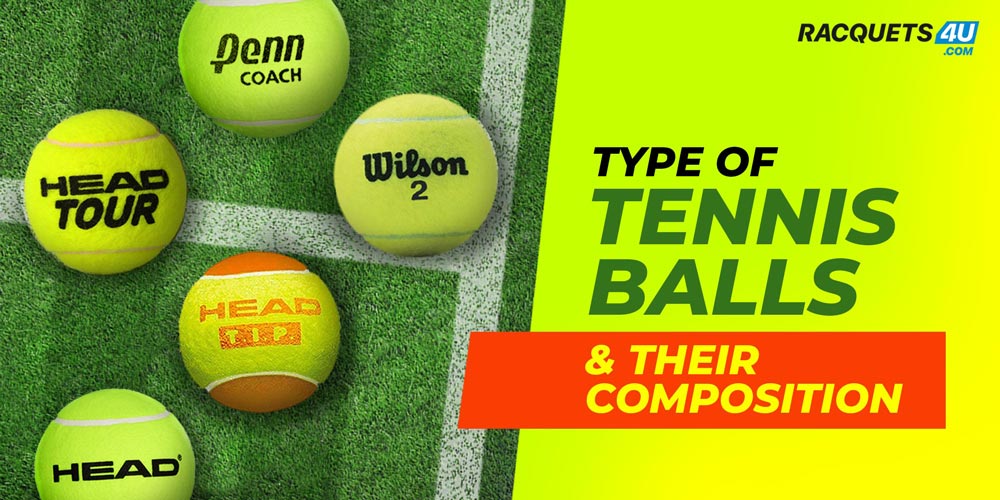It might look easy to choose the right tennis ball at first glance but it’s not the same. Picking the right tennis ball will include many factors such as level of play, type of surface, and more.
At first look all tennis balls look similar and even smell same but the huge difference arises from their types and composition.
First let’s start with its type.

TYPE OF TENNIS BALLS:
EXTRA DUTY TENNIS BALLS (XD BALLS)
Extra Duty Tennis Balls are basically made for hard surfaces which include concrete, asphalt, and other major outdoor hard courts. Extra Duty is best known for its durability as they are thick felt balls and will go longer on all types of matches.
The felt available on these XD tennis balls, help in balancing out ball on most courts. Although extra Duty Tennis Balls provides longer durability but they may not be fast as regular duty balls are.
Some of the Extra Duty Tennis Balls are –
a. PENN Coach Tennis Ball Carton (72 Balls)
b. WILSON Championship Tennis Ball Carton (72 Balls)
c. PENN Championship Extra Duty Tennis Ball Carton (72 Balls)
d. PENN Championship Titanium Tennis Ball Carton (72 Balls)
e. PENN Pro Marathon Tennis Ball Carton (72 Balls)
- REGULAR DUTY TENNIS BALLS (RD BALLS)
Regular Duty Tennis balls are known for providing the best features on softer, slower clay courts. It has less felt as compared to extra duty tennis balls making them ideal ball for clay courts.
Regular Ball’s felt is made like extra duty balls as a result giving longer durability on the court. Moreover, this felt will aid in speeding up the tennis ball on the slower courts. If you are thinking to use these balls in hard courts, of course; you can but they are not as durable as extra duty balls are.
Some of the Regular Duty Tennis Balls are –
a. DUNLOP AO Tennis Ball Carton (72 Balls)
b. WILSON Tour Premier Tennis Ball Carton (72 Balls)
c. HEAD Tour Tennis Ball Carton (72 Balls)
d. SLAZENGER Wimbledon Tennis Ball Carton (72 Balls)
e. HEAD Tour XT Tennis Ball Carton (72 Balls)
- PRESSURELESS BALLS
Pressure-less tennis balls are referred to as beginner’s balls. These balls are more durable as compared to regular duty tennis balls making them ideal for recreational or training players.
Pressure-less balls are filled with compressed air making their walls thicker on the core, its unique core will help in retaining bounce even after a period of a long time. So, pressure-less balls give an extra layer of practicing matches.
Some of the Pressureless Tennis Balls are –
a. HEAD Tip-I Tennis Ball Carton (72 Balls)
b. HEAD Tip-II Tennis Ball Carton (72 Balls)
c. HEAD Tip-III Tennis Ball Carton (72 Balls)
d. WILSON Trinity All Court Tennis Ball Carton (72 Balls)
e. TRETORN Serie + Tennis Ball Carton (72 Balls)
- HIGH ALTITUDE BALLS
To counter the effect of high altitude, new type of ball was introduced. Altitude balls are basically designed to play over the height of 4,000 feet. These balls generally fly much higher and bounce faster on the court.
Some of the Altitude Tennis Balls are –
a. HEAD Tour High Altitude Tennis Ball Can
b. HEAD Tour High Altitude Tennis Ball Dozen
c. HEAD Tour High Altitude Tennis Ball Carton
- JUNIOR BALLS
Just like choosing the perfect shoe or racket have an adverse effect on a child’s skill development. Giving the right tennis balls according to age will also be helpful in growing towards the right path.
Foam Balls are mainly designed for the smallest and slowest age group that is from 3 to 5 years.
Red Balls provide a firmer feel on the court as it has more pressure inside it as compared to foam balls. These balls are suitable for 6-8 years old kids.
Orange Balls which are meant for the age group (9-10 years) have much more pressure as compared to other kid’s balls and its circumference is also small as compared to foam and red balls.
Green Balls are the last junior balls, categorized meant for 11-13 years, and is very close to the regular adult balls.
COMPOSITION OF TENNIS BALL:
When looking upon the parts of the composition made, it has three main components.
Sr.no Composition Material or Nature
1 The Felt Yellow Fuzzy Stuff
2 The Core Natural or Synthetic Rubber
3 The Air or Gas Pressurization
Tennis ball composition
THE FELT
The felt (yellow fuzzy stuff) is the key component of how a ball performs on the court. The type of material tailored and the way it is being embedded make it a premium or entry-level ball. Most of the tennis balls these days being sold in the market consist of natural woolen blend and have synthetic nylon fibers on the outer surface of the ball.
- THE CORE
Tennis balls are made from natural or synthetic rubber core which is pressed by the steel rollers and heated out to form biscuit-like shapes known as slugs. Then, slugs are shaped and molded to make a half sphere and two half-sphere finally are fixed together to make a tennis ball.
- THE AIR OR GAS
All the championship balls or premium balls that are sold on major online shoppers such as racquets 4u are filled with natural air.
Also read if you are looking for best tennis balls of 2021
Conclusion,
The mentioned types and composition will definitely be helpful in deciding on a reasonable tennis ball. If you think we should a

That's actually way more complicated than you think. Well, I haven't played tennis for a long time because I'm way too old for it already, but I regularly watch tennis matches and place bets on https://takebet.ph/ because it's the only thing I can do. I want to play tennis, but I just don't have the ability.